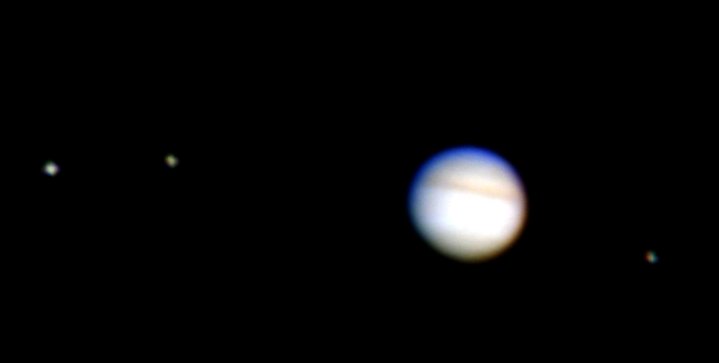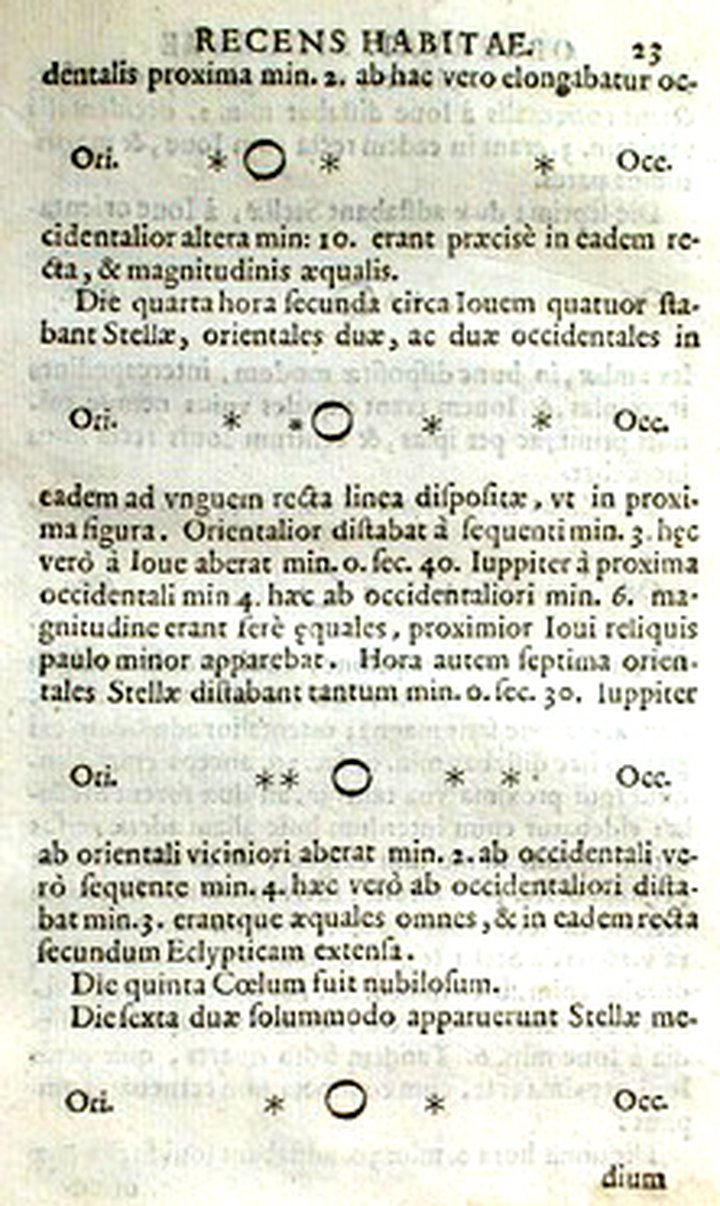If you’ve got a pair of binoculars, and assuming clear skies, I encourage you to check out the planet Jupiter one evening this week. It’s almost as close to Earth as it ever gets (under 400 million miles), meaning that with half-decent binocs, and even in the glare of streetlights, you should be able to see three or four of its moons.

Amateur telescope view of Jupiter with three of its four “Galilean” moons. (Thomas Bresson, Creative Commons)
To find Jupiter, just look east after sunset. You can’t miss it, it’s big and bold, an easy target for binoculars. The trick is to hold them really steady — propped up on a fence post or the top of a car — and make sure you’re perfectly in focus: adjust for your pupil distance, then close your right eye and focus with the main knob, then close your left eye and focus with the adjustable right eyepiece. Breathe slowly and steadily so Jupiter isn’t jumping up and down and notice what’s happening on either side of the planet: you should see tiny dots in a straight line, ideally four of them, either two one side and two on the other, or three and one, or four and none.
Back in January 1610 (or possibly December 1609), this sight was A Very Big Deal. Despite earlier theoretical attempts to show that the Earth and other planets orbited the sun, rather than everything going around the Earth (originally by Aristarchus of Samos around 250 BC and — much later — by Nicolas Copernicus) it was hard to prove this with the naked eye.
The invention of the telescope (in Holland around 1608) changed all that. When Galileo Galilei, a math teacher in Padua, Italy, heard about this new-fangled gadget, he built his own: first with 8X magnification, later 20X. Soon after his first observations of the night sky, he spotted for the first time* what we now call Jupiter’s “Galilean moons”: Io, Europa, Callisto and Ganymede, all lovers of Zeus (Roman Jupiter) in Greek myth. Noticing the positions of the four objects changing from night to night, he correctly deduced that they were orbiting around the planet.
[* Or maybe not the first time. Chinese astronomer-astrologer Gan De noted “a small reddish star” close to Jupiter in 362 BC, perhaps Jupiter’s moon Ganymede. In theory, it’s possible to see Ganymede and the other three bright moons with the naked eye under ideal viewing conditions, by blocking out the glare of the planet by occluding it — behind a tree, for instance.]

Page from Galileo’s “Sidereus Nuncius” (“Starry Messenger”) published in 1610, showing Jupiter’s moons changing positions. “Behold, therefore, four stars…make their journeys and orbits with a marvelous speed around the star of Jupiter…like children of the same family.” (Wikipedia Commons)
The reason this was such a big deal is that it dealt a blow to the “Ptolemiac System” (after Claudius Ptolemy, 100-170 AD) that had all celestial bodies orbiting Earth, including, of course, our moon. The discovery of Jupiter’s moons meant that Earth wasn’t quite so special after all! If moons could orbit another planet, perhaps it was true, as Copernicus said, that the Earth orbited the sun. (The nail in the coffin of Ptolemy’s Earth-centered system was Galileo’s observations of the phases of Venus — hitherto unknown — shortly after his discovery of Jupiter’s moons, proving that Venus orbited the sun, not Earth.)
Streetlights have changed our relationship with the night sky. Just a hundred or so years ago, you could have asked anyone what that bright light was in the sky, or what was the phase of the moon, and they’d have known, as we know, for instance, what day of the week it is — or a fisherman knows the state of the tide. Streetlights have brought safety, but they have taken away our intimacy with the heavens. You can reclaim that by driving up to Kneeland airport in the evening and gulping in the Milky Way. Or, less ambitiously, reexperiencing Galileo’s astonishment at seeing Jupiter’s moons — from your backyard. They’re waiting for you!
CLICK TO MANAGE